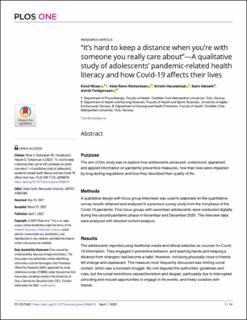| dc.contributor.author | Riiser, Kirsti | |
| dc.contributor.author | Richardsen, Kåre Rønn | |
| dc.contributor.author | Haraldstad, Kristin | |
| dc.contributor.author | Helseth, Sølvi | |
| dc.contributor.author | Torbjørnsen, Astrid | |
| dc.date.accessioned | 2023-01-05T11:44:44Z | |
| dc.date.available | 2023-01-05T11:44:44Z | |
| dc.date.created | 2022-04-05T09:02:36Z | |
| dc.date.issued | 2022-04-01 | |
| dc.identifier.citation | PLOS ONE. 2022, 17 (4), e0266510-?. | en_US |
| dc.identifier.issn | 1932-6203 | |
| dc.identifier.uri | https://hdl.handle.net/11250/3041194 | |
| dc.description.abstract | Purpose: The aim of this study was to explore how adolescents accessed, understood, appraised, and applied information on pandemic preventive measures, how their lives were impacted by long-lasting regulations and how they described their quality of life.
Methods: A qualitative design with focus group interviews was used to elaborate on the quantitative survey results obtained and analyzed in a previous survey study from the first phase of the Covid-19 pandemic. Five focus groups with seventeen adolescents were conducted digitally during the second pandemic phase in November and December 2020. The interview data were analyzed with directed content analysis.
Results: The adolescents reported using traditional media and official websites as sources for Covid-19 information. They engaged in preventive behavior, and washing hands and keeping a distance from strangers had become a habit. However, not being physically close to friends felt strange and unpleasant. The measure most frequently discussed was limiting social contact, which was a constant struggle. No one disputed the authorities’ guidelines and rules, but the social restrictions caused boredom and despair, particularly due to interrupted schooling and missed opportunities to engage in life events, and freely socialize with friends.
Conclusion: The adolescents gave an overall impression of being health literate, which corresponds well with the results from our previous survey study. Their descriptions of how they translated protective measures into their everyday lives demonstrate that they took responsibility and accepted personal costs for the collective good. However, life with social restrictions decreased their quality of life. | en_US |
| dc.language.iso | eng | en_US |
| dc.publisher | Public Library of Science | en_US |
| dc.relation.ispartofseries | PLOS ONE;17 (4): e0266510 | |
| dc.rights | Navngivelse 4.0 Internasjonal | * |
| dc.rights.uri | http://creativecommons.org/licenses/by/4.0/deed.no | * |
| dc.subject | Adolescents | en_US |
| dc.subject | Pandemics | en_US |
| dc.subject | Schools | en_US |
| dc.subject | Quality of life | en_US |
| dc.subject | Qualitative studies | en_US |
| dc.subject | Health education | en_US |
| dc.subject | Social media | en_US |
| dc.title | “It’s hard to keep a distance when you’re with someone you really care about”—A qualitative study of adolescents’ pandemic-related health literacy and how Covid-19 affects their lives | en_US |
| dc.type | Peer reviewed | en_US |
| dc.type | Journal article | en_US |
| dc.description.version | publishedVersion | en_US |
| dc.rights.holder | © 2022 Riiser et al. | en_US |
| dc.source.articlenumber | e0266510 | en_US |
| cristin.ispublished | true | |
| cristin.fulltext | original | |
| cristin.qualitycode | 1 | |
| dc.identifier.doi | https://doi.org/10.1371/journal.pone.0266510 | |
| dc.identifier.cristin | 2015293 | |
| dc.source.journal | PLOS ONE | en_US |
| dc.source.volume | 17 | en_US |
| dc.source.issue | 4 | en_US |
| dc.source.pagenumber | 1-14 | en_US |

